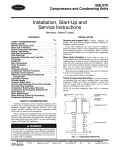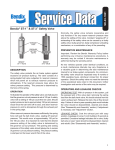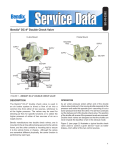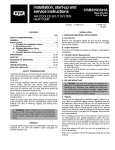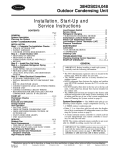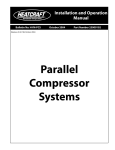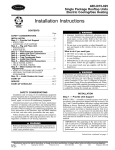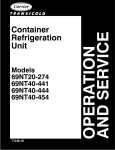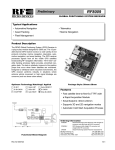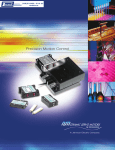Download Carrier Compressor and Condensing Unit User's Manual
Transcript
06E,07E Compressors and Condensing Units Installation, Start-Up and Service Instructions Hermetic, Water-Cooled CONTENTS INSTALLATION Page SAFETY CONSIDERATIONS . . . . . . . . . . . . . . . . . . . . . . 1 INSTALLATION . . . . . . . . . . . . . . . . . . . . . . . . . . . . . . . . . 1-6 Receive and Inspect Unit . . . . . . . . . . . . . . . . . . . . . . . . . 1 Place Unit in Position . . . . . . . . . . . . . . . . . . . . . . . . . . . . 1 Check Compressor Mounting . . . . . . . . . . . . . . . . . . . . 1 Piping Connections . . . . . . . . . . . . . . . . . . . . . . . . . . . . . . 2 Electrical Connections . . . . . . . . . . . . . . . . . . . . . . . . . . . 2 PRE-START-UP . . . . . . . . . . . . . . . . . . . . . . . . . . . . . . . . . .7,8 Evacuate, Dehydrate, and Leak Test. . . . . . . . . . . . . . 7 Oil Charge. . . . . . . . . . . . . . . . . . . . . . . . . . . . . . . . . . . . . . . . 7 START-UP . . . . . . . . . . . . . . . . . . . . . . . . . . . . . . . . . . . . . . . . 8 Start Compressor . . . . . . . . . . . . . . . . . . . . . . . . . . . . . . . . 8 Timer Functions. . . . . . . . . . . . . . . . . . . . . . . . . . . . . . . . . . 8 SERVICE . . . . . . . . . . . . . . . . . . . . . . . . . . . . . . . . . . . . . . 9-18 Protection Devices . . . . . . . . . . . . . . . . . . . . . . . . . . . . . . . 9 Compressor Thermal Protection . . . . . . . . . . . . . . . . . 9 Capacity Control System . . . . . . . . . . . . . . . . . . . . . . . . . 9 Removing, Inspecting and Replacing Components . . . . . . . . . . . . . . . . . . . . . . . . . . . . . . . . . . 10 Lubrication System . . . . . . . . . . . . . . . . . . . . . . . . . . . . . 13 Cylinder Heads. . . . . . . . . . . . . . . . . . . . . . . . . . . . . . . . . . 14 Pressure Relief Valve. . . . . . . . . . . . . . . . . . . . . . . . . . . . 14 Suction and Discharge Valve Plate Assembly . . . 14 Terminal Plate Assembly . . . . . . . . . . . . . . . . . . . . . . . . 14 Compressor Running Gear Removal . . . . . . . . . . . . 14 Compressor Running Gear Replacement. . . . . . . . 15 Motor Removal . . . . . . . . . . . . . . . . . . . . . . . . . . . . . . . . . . 16 Motor Replacement . . . . . . . . . . . . . . . . . . . . . . . . . . . . . 16 Motor Burnout (Clean-Up Procedure). . . . . . . . . . . . 17 Condenser Maintenance . . . . . . . . . . . . . . . . . . . . . . . . 17 Receive and Inspect Unit — Inspect shipment for damage. File claim with the shipping company if shipment is damaged or parts are missing. Local water conditions can cause excessive fouling or pitting of condenser tubes. If such conditions are anticipated, a water treatment analysis is recommended. Refer to Carrier System Design Manual, Part 5, for general water conditioning information. SAFETY CONSIDERATIONS Installing, starting up, and servicing this equipment can be hazardous due to system pressures, electrical components, and equipment location (roofs, elevated structures, etc.). Only trained, qualified installers and service mechanics should install, start up, and service this equipment. When working on the equipment, observe precautions in the literature, tags, stickers and labels attached to the equipment, and other safety precautions that apply. Follow all safety codes. Wear safety glasses and work gloves. Use care when handling, rigging, and setting bulky equipment. Electrical shock can cause personal injury and even death. Be sure power to equipment is shut off before installing or servicing this equipment. There may be more than one disconnect. Tag disconnect(s) to alert others not to turn power on until work is completed. Place Unit in Position — Locate unit on floor in a well-ventilated area. Install unit where it will be warmer than conditioned area. Position it to allow sufficient space for refrigerant and water connections and to service compressor. Allow space at one end of condenser for tube cleaning or replacement. Place unit so suction and discharge valves can be easily reached and so oil level can be checked. Make provision in piping layout to drain and vent condenser if system is to be shut down in winter. Level unit and bolt firmly to foundation. Check Compressor Mounting — Loosen compressor mounting bolts and remove shipping blocks from under compressor. Tighten all 4 bolts on compressor. Loosen each bolt just enough until the flanged washer can be moved sideways with finger pressure. See Fig. 1. NOTE: Be sure that compressor floats freely on mounting springs. SELF-LOCKING BOLT SNUBBER FLANGED WASHER NEOPRENE SNUBBER COMPRESSOR FOOT ISOLATION SPRING Fig. 1 — Compressor Mounting Manufacturer reserves the right to discontinue, or change at any time, specifications or designs without notice and without incurring obligations. PC 802 Catalog No. 530-601 Printed in U.S.A. Form 06/07E-1SI Pg 1 5-01 Replaces: 06E,07E-9SI Book 2 2 4 4 Tab 1b 2a 2b 3a Piping Connections — Attach water supply and return lines to connections indicated on condensing unit (Fig. 2). Water leaving condenser should not be connected directly into sewer lines; check local codes. Attach refrigerant liquid and suction lines to condensing unit (Fig. 2); suction and discharge lines to compressor unit (Fig. 3 and 4). Discharge line muffler and check valve are factory supplied with 06E compressor units. Install the muffler as close to shutoff valve as possible and install the check valve in the discharge line close to the muffler, on the downstream side. When soldering or brazing piping to valves, disassemble the valve or wrap it in wet cloth to prevent damage by heat. Allow flexibility in suction line so compressor suction valve may be moved aside for access to suction strainer. A solenoid valve is necessary for single pumpout control used on 06E and 07E units. Install the valve (field supplied) in the liquid line, just before expansion valve. A filter drier of adequate size should be installed in liquid line between condenser and solenoid valve. Pressure relief valve located on top of condenser will open to relieve excessive pressure, allowing refrigerant to escape. Most local codes require piping from valve to outdoors. Refer to Carrier System Design Manual for standard piping techniques. 243 + 236 + 238 3 717 = 3 = 239 volts Average Voltage = Determine maximum deviation from average voltage: (AB) 243 – 239 = 4 volts (BC) 239 – 236 = 3 volts (AC) 239 – 238 = 1 volt Maximum deviation is 4 volts. Determine % voltage imbalance: 4 % Voltage Imbalance = 100 x = 1.7% 239 This amount of phase imbalance is satisfactory as it is below the maximum allowable 2%. IMPORTANT: If the supply voltage phase imbalance is more than 2%, contact your local electric utility company immediately. Allowing the unit to operate with a voltage imbalance in excess of 2% may void the warranty. POWER SUPPLY — Field wiring must comply with local and national codes. See Table 1. Install a branch circuit fused disconnect of adequate size to handle starting current. The disconnect must be within sight from the unit and readily accessible, in compliance with National Electrical Code (NEC), Section 440-14. Line power is brought into control center through indicated opening. Connect line power supply to terminal block TB1; connect power leads to terminals L1, L2 and L3. Connect control circuit power supply (115 volts) to terminals 1 and 15 on terminal block TB2. Refer to Fig. 5. Wiring connections for field-supplied equipment are shown on wiring diagram. See Fig. 5. ACCESSORIES — Field-installed accessories for the 06E and 07E units are control circuit transformer and gage panel (3 gages). Refer to accessory literature for installation instructions. Electrical Connections UNBALANCED 3-PHASE SUPPLY VOLTAGE — Never operate a motor where a phase imbalance in supply voltage is greater than 2%. Use the following formula to determine the % voltage imbalance: % Voltage Imbalance = max voltage deviation from avg voltage 100 x average voltage Example: Supply voltage is 240-3-60 AB = 243 volts BC = 236 volts AC = 238 volts 2 3 VOLTS 208/230 460, 575 208/230 460, 575 208/230 460, 575 208/230 460, 575 A 66 66 78 78 78 78 691/2 691/2 B 493/4 433/4 493/4 433/4 493/4 433/4 493/4 493/4 C 23/4 23/4 23/4 23/4 23/4 23/4 23/4 23/4 D 34 34 34 34 34 34 34 34 E 271/2 26 271/2 26 271/2 26 271/2 271/2 F 1 1 1 1 1 1 1 1 Fig. 2 — 07E Water-Cooled Condensing Units NOTES: 1. Recommended service space for removal of motor at compressor motor end is 3 ft. 2. Recommended service space for removal of tube is one condenser length at either end. D044 B033 B027 A022 UNIT 07E DIMENSIONS (in.) G 21 21 21 21 21 21 21 21 H 59/16 59/16 59/16 59/16 59/16 59/16 41/8 41/8 I 95/16 95/16 95/16 95/16 95/16 95/16 85/8 85/8 NOTE: Recommended service space is 3 ft-0 in. at compressor motor end to allow for motor removal. DIMENSIONS (in.) 06E UNIT V022 W027 W033 W044 VOLTAGE 208/230 460,575 208/230 460,575 208/230 460,575 208/230 460,575 A 481/4 481/4 501/4 501/4 501/4 501/4 501/4 501/4 B 35 29 35 29 35 29 35 35 C 367/8 367/8 367/8 367/8 367/8 367/8 367/8 367/8 D 11/2 11/2 11/2 11/2 11/2 11/2 11/2 11/2 Fig. 3 — 06E Hermetic Compressor Units Fig. 4 — 06E Compressors 4 E 271/2 26 271/2 26 271/2 26 271/2 271/2 F 1 1 1 1 1 1 1 1 G 191/2 191/2 191/2 191/2 191/2 191/2 191/2 191/2 Table 1 — Electrical Data — Compressor Motor With Circuit Breaker COMPRESSOR MOTOR DATA Compressor Voltage Part (3 Ph - 60 Hz) Hp Number 06E 250 265 A 275 299 LRA MHA MTA PW RLA XL — — — — — — 208/230 575 460 208/230 575 460 208/230 575 460 208/230 575 460 20 25 30 40 CIRCUIT BREAKER Motor Maximum LRA-PW Recommended Maximum Winding Recommended Must Trip LRA-XL (first RLA Resistance Circuit Breaker MHA MTA LRA RLA Amps winding) Part No. (Ohms) 108 87 345 207 0.32 HH83XB336 91 104 350 74.3 45 36 120 72 2.2 XA461 33 38 124 27.1 54 44 173 104 1.3 XA424 42 49 175 35.0 140 112 446 268 0.27 HH83XC509 110 127 420 90.7 57 46 164 98 1.6 XA469 46 53 164 37.9 70 56 223 134 1.1 XA426 55 643 210 45.7 168 135 506 304 0.22 HH83XC539 142 163 507 116.4 65 52 176 106 1.3 XA430 50 58 168 41.4 84 68 253 152 0.9 XA425 63 73 210 52.1 236 189 690 414 0.15 HH83XC537 187 215 636 153.6 94 75 276 165 1.0 XA551 74 85 236 60.7 118 95 345 207 0.58 XA550 92 106 295 75.7 LEGEND Locked Rotor Amps Must Hold Amps Must-Trip Amps Part-Winding (Start) Rated Load Amps Across-the-Line (Start) 4. Recommended RLA value shown is determined by: circuit breaker must trip value ÷ 1.40. Use this recommended (and minimum) RLA value to determine nameplate stamping, minimum contactor sizing, and wire sizing. RECOMMENDED RLA FOR 06E COMPRESSORS EQUALS: MUST-TRIP (MTA) OF CARLYLE APPROVED OVERCURRENT DEVICE BEING USED ÷ 1.40 5. Compressor operating amps at any specific condition can only be determined from a performance curve. 6. Ohm values for resistance are approximate and shown for reference purposes only. Motors from different vendors and motors of different efficiencies can differ up to 15% from data shown. 7. Electrical data for compressor part numbers 06ER, 06EM and 50 Hz models (not shown) are available from Carrier Sales Representative. *Refer to physical data table to match compressor with correct compressor or water-cooled condensing unit. NOTES: 1. Compressor MTA and RLA values are maximum figures. 2. LRA values for PW second winding = 1/2 the LRA – XL value. 3. 3-Pole XL circuit breakers shown, other 3-Pole XL alternates and 6-Pole PW breakers available. Terminal lugs for circuit breakers available in package 06EA660152 (not shown). C1 C2 CCB CHR CR FU GND HPS LPS NEC NEMA — — — — — — — — — — — OPS POR TB TDR TM TR — — — — — — LEGEND Compressor Contactor Compressor Contactor (PW) Compressor Circuit Breaker Crankcase Heater Relay Control Relay Fuse Ground High-Pressure Switch Low-Pressure Switch National Electrical Code National Electrical Manufacturer’s Association Oil Pressure Switch Pumpout Relay Terminal Block Time Delay Relay Timer Motor Timer Relay Fig. 5 — Component Location 5 LEGEND AUX — Auxiliary C — Compressor Contactor C1 — Compressor Contactor (XL start and first step of PW start) C2 — Compressor Contactor (PW second step) CH — Crankcase Heater CHR — Crankcase Heater Relay CR — Control Relay DTS — Discharge Temperature Sensor DX — Direct Expansion FU — Fuse HPS — High-Pressure Switch LLS — Liquid Line Solenoid Valve LPS — Low-Pressure Switch M1 M2 M3 NEC OPS POR PW SW TB TDR TM TR XL — Evaporator Fan or Chilled Water Pump — Cooling Tower Pump — Cooling Tower Fan — National Electrical Code — Oil-Pressure Switch — Pumpout Relay — Part Wind — Start-Stop-Reset Switch — Terminal Block — Time Delay Relay — Timer Motor — Timer Relay — Across-the-Line NOTES: 1. Factory wiring is in compliance with NEC. Any field modifications or additions must be in compliance with all applicable codes. Use copper, copper-clad aluminum for field power supply only. 2. Field power supply wiring must be 75 C minimum. 3. Compressor thermally protected. Three-phase motors are protected against primary single-phasing condition. 4. Pilot duty control must be field supplied. Minimum contact rating must be 25 va. 5. 60 Hz units have 120 volt control circuit. 50 Hz units have 230 volt control circuit. A separate source of supply at the correct voltage must be field supplied supply at the through a fused disconnect 6. 7. 8. 9. 10. Unmarked Terminal Marked Terminal Factory Wiring Field Control Wiring To indicate common potential only; not to represent wiring. Splice device with a maximum rating of 15 A to TB2 connections L1 (Hot Side) and L2 (Neutral). Open control circuit disconnect switch for servicing only. Disconnect must remain closed for crankcase heater to operate. A transformer of the following rating may be field supplied for 60 Hz units: 350 va. Transformer must be fused and grounded per applicable codes. If any of the original wiring furnished must be replaced, it must be replaced with 90 C wire or its equivalent. Wiring is shown for single pumpout control. Single pumpout control should not be used on direct-expansion (DX) cooler applications (see lower diagram for wiring when applied with DX cooler). Fig. 6 — Control Circuit Wiring for 06E/07E Units 6 Terminal Block Connector PRE-START-UP operation. To add or remove oil, see Carrier Standard Service Techniques Manual, Chapter 1, Refrigerants. IMPORTANT: Use only Carrier approved compressor oil. Do not reuse oil that has been drained and do not use oil that has been exposed to atmosphere. When charging, or when removing charge, circulate water through water-cooled condenser and cooler continuously to prevent freezing. Freezing damage is considered abuse and is not covered by Carrier warranty. Approved compressor oils*: Petroleum Specialties, Inc. . . . . . . . . . . . . . . . . . . . . . Cryol 150 Texaco, Inc. . . . . . . . . . . . . . . . . . . . . . . . . . . . . Capella WR-32 Witco Chemical Co.. . . . . . . . . . . . . . . . . . . . . . . . . Suniso 3GS Evacuate, Dehydrate, and Leak Test — The entire refrigerant system must be evacuated, dehydrated and leak tested by methods described in Carrier Standard Service Techniques Manual, Chapter 1, Section 1-6 and 1-7. Use sight glass method to charge system. See Section 1-8 of Service Techniques Manual for details. Charge the system to a clear sight glass while holding saturated condensing pressure constant at 125 F (air-cooled systems) or 105 F (water-cooled systems). Add additional refrigerant to fill condenser subcooler coils for air-cooled applications. *Approved for R-12, R-22, R-502 refrigerants. Contact Carrier Factory Sales Representative for other refrigerants. TO ADD OIL — Close suction shutoff valve and pump down crankcase to 2 psig. (Low-pressure cut-out must be bypassed.) Wait a few minutes and repeat as needed until pressure remains at 2 psig. Remove oil fill plug above bull’s-eye, add oil through plug hole and replace plug. Run compressor for about 20 minutes and check the oil level. TO REMOVE OIL — Pump down compressor to 2 psig. Loosen the 1/4-in. pipe plug in compressor base and allow the oil to seep out past the threads of the plug. The crankcase will be under slight pressure. Be careful not to remove the plug; the entire oil charge may be lost. Oil Charge (See Tables 2 and 3) — All units are factory charged with oil. If oil is visible in sight glass, start compressor. Observe level and add oil, if required, to bring level in crankcase 1/8 to 3/8 of bull’s-eye during steady Table 2 — 06E Physical Data UNIT 06E OPERATING WEIGHT (lb) REFRIGERANT COMPRESSOR — 06E* Cylinders Bore (in.) Stroke (in.) Displacement (cfm at 1750 rpm) Maximum Rpm Oil Charge (pt) High Side Maximum Pressure (psi) Low Side Maximum Pressure (psi) CONNECTIONS (in.) Suction Valve (ODF) Discharge Valve (ODF) V022 600 W027 W033 640 650 R-134a, R-22, R-507/404A A265 A275 6 6 211/16 211/16 2 23/16 68 75 1750 19 19 450 PSIG 245 PSIG A250 4 211/16 23/16 50 14 15/8 11/8 15/8 13/8 LEGEND ODF — Outside Diameter Female *Compressors listed are for R-22 applications. For R-134a an 06EM compressor is standard offering; an 06ER compressor is standard for R-507/404A. Factory compressor substitutes may be made. Contact Carrier Sales Representative. 7 21/8 13/8 W044 670 A299 6 211/16 27/8 99 19 21/8 15/8 Table 3 — 07E Physical Data UNIT 07E OPERATING WEIGHT (lb) REFRIGERANT COMPRESSOR — 06E* Cylinders Bore (in.) Stroke (in.) Displacement (cfm at 1750 rpm) Oil Charge (pt) High Side Maximum Pressure (psi) Low Side Maximum Pressure (psi) CONDENSER (Shell and Tube)† Part Number Refrigerant Storage Capacity (lb) R-134a R-22 Min Refrigerant Operating Charge (lb) R-507/404A A022 1090 A250 4 211/16 23/16 50 14 P701-0840AX 71.3 15.4 70.4 15.1 61.1 15.1 REFRIGERANT CONNECTION (in. ODF) Inlet Outlet WATER CONNECTION (in. FPT) Inlet/Outlet B027 B033 1200 1250 R-134a, R-22, R-507/404A A265 A275 6 6 211/16 211/16 2 23/16 68 75 19 19 450 245 P701-0850AX P701-0850AX 85.90 85.90 18.67 18.67 84.80 84.80 18.30 18.30 73.60 73.60 18.30 18.30 D044 1410 A299 6 211/16 27/8 99 19 P701-1065AX 112.70 23.77 111.20 23.30 96.50 23.30 21/8 13/8 21/8 13/8 21/8 13/8 25/8 15/8 21/2 21/2 21/2 3 LEGEND FPT — Female Pipe Thread ODF — Outside Diameter, Female *Compressor listed is the standard compressor for R-22, air conditioning duty. An 06ER compressor is standard equipment for low temperature (R-507/404A) applications. For medium temperature (R-134a) applications, an 06EM compressor is standard. Factory substitutions may be made. Contact Carrier Sales Representative. †The condenser listed is for R-22, air conditioning duty and may change based on the application. Maximum condenser operating pressure: 350 psi refrigerant side, 150 psi water side. START-UP Timer Functions (See Fig. 7 — Timer Cycle.) 1. Switch A (contacts A-A1 and A-A2) provides Time Guard® function. Start of compressor is delayed approximately 5.5 minutes after shutoff. The minimum time between starts of compressor is 8 minutes. 2. Switch B (contacts B-B1 and B-B2) starts compressor and deenergizes the crankcase heater. These contacts also provide one-second time delay for part-winding start. 3. Switch E (contacts E-1) provides approximately 40-second bypass of oil pressure switch (OPS) at start-up. Compressor will shut off if sufficient oil pressure does not build up. 4. Switch D (contacts D-D1) bypasses the low-pressure switch (LPS) for 2.5 minutes at start-up for winter start control. Energize crankcase heater at least 24 hours prior to start-up. Check to see that oil level is approximately 1/3 up on the compressor sight glass. Open water supply valve and allow water to reach condenser. (Turn condenser fan on when the compressor unit is applied with air-cooled condenser.) Backseat the compressor suction and discharge shutoff valves; open liquid line valve at receiver. Start evaporator fan or chilled water pump. Do not attempt start-up with terminal cover removed from compressor. Bodily injury or death may result from explosion and/or fire if power is supplied to compressor with the terminal cover removed or unsecured. See warning label on terminal cover. Start Compressor — Push the control circuit STARTSTOP-RESET switch to START. The timer motor starts immediately. Depending on the position of the timer, the compressor start is delayed for 12 seconds to approximately 8 minutes. Check oil pressure after compressor has run a few minutes; the pressure should be 12 to 18 psi above the suction pressure. After about 20 minutes of operation, stop the compressor. Allow it to be idle for about 5 minutes, then observe the oil level in the sight glass. Refer to the Carrier Standard Service Techniques Manual, Chapter 1, Section 1-11, for adding oil. The proper oil level for the 06E compressor is approximately 1/3 up on sight glass. Fig. 7 — Timer Cycle 8 SERVICE exceeds 295 ± 5 F, the sensor contacts open and the compressor shuts down. The sensor reset temperature is 235 F minimum. See Fig. 8 for control circuit connections. Protection Devices HIGH-PRESSURE SWITCH — Check by throttling condenser water or blocking airflow on air-cooled units, allowing head pressure to rise gradually. Check discharge pressure constantly throughout procedure. Compressor should shut off within 10 psi of values shown in Table 4. LOW-PRESSURE SWITCH — Check by slowly closing suction shutoff valve or by completely closing liquid line shutoff valve. A decrease of suction pressure will follow. Compressor should shut off within 4 psi of values shown in Table 4. OIL PRESSURE SWITCH (OPS) — The oil pressure switch protects against damage from loss of oil or loss of oil pressure during unit start-up. If the oil pressure differential sensed by the OPS is 6 psig or less on unit start-up, the switch remains closed and the OPS heater is energized. The switch time delay is approximately 45 seconds. If after 45 seconds the oil pressure differential sensed by the OPS is less than 11 psig, the heater remains energized. The OPS temperature actuated switch then opens and the compressor is deenergized. If the differential reaches 11 psig, the OPS opens and deenergizes the heater and the system operates normally. See Table 4. Capacity Control System CAPACITY CONTROL VALVE (Fig. 9) — Valve is controlled by suction pressure and actuated by discharge pressure. Each valve controls 2 cylinders. On start-up, controlled cylinders do not load up until differential between suction and discharge pressures is approximately 25 psi. See Table 5. IMPORTANT: Do not use automatic pumpdown control on 06E,07E units equipped with unloader valves. Use single pumpout or solenoid drop (minimum protection) control. CAPACITY CONTROL VALVE ADJUSTMENTS Control Set Point (Cylinder Load Point) — Adjustable from 0 to 86 psig. Pressure differential between cylinder load-up point and cylinder unload point is adjustable from 6 psi to 16 psi. CR 4 6 RED C1 C2 C2 C2 YEL C1 BLU TIMER CONTACTS IMPORTANT: If the oil pressure switch causes unit lockout, determine and correct the cause of the lockout (such as loss of compressor oil or flooded compressor) before restarting the unit. Failure to correct the cause of OPS lockout may constitute abuse. Equipment failure due to abuse is not covered by warranty. B2 DTS B ORN BLU TB2 B1 C CR DTS TB To restart the unit, push the OPS reset button and then push the control circuit switch on the unit control box to OFF and then to ON. • — — — — 6 LEGEND Compressor Contactor Control Relay Discharge Temperature Sensor Terminal Block Splice (in compressor junction box) Fig. 8 — Discharge Temperature Sensor (DTS) Table 4 — Factory Switch Settings SWITCH TYPE High Pressure Low Pressure Oil Pressure PRESSURE CHANGE AFFECTING SWITCH POSITION (psig) Closed Open 210 (±10) 290 (±10) 70 (±4) 60 (±4) 6 11 CONTROL SET POINT ADJUSTMENT NUT NOTES: 1. Values for the high- and low-pressure switches based on R-22. For other refrigerants, reset to pressure corresponding to saturation temperatures indicated by the listed pressures. 2. Values for oil pressure are above operating suction pressure (pressure differential between suction and discharge pressures of oil pump). TIME GUARD® CONTROL — The Time Guard control protects against short cycling. See Start Compressor. CRANKCASE HEATER — The crankcase heater prevents absorption of liquid refrigerant by oil in crankcase during brief or extended shutdown periods. Source of 115-volt power is the auxiliary control power, independent of the main unit power. This assures compressor protection even when main unit power disconnect switch is off. VALVE BODY IMPORTANT: Never open any switch or disconnect that will deenergize the crankcase heater unless unit is being serviced or is to be shut down for a prolonged period. After a prolonged shutdown or a service job, energize the crankcase heater for 24 hours before starting the compressor. SEALING CAP (COVERS PRESSURE DIFFERENTIAL ADJUSTMENT SCREW) Compressor Thermal Protection — A discharge Fig. 9 — Capacity Control Valve temperature sensor, installed in one cylinder head, detects an overtemperature condition. If the discharge temperature 9 Replacing Suction Cutoff Unloading Heads — When the original compressor is equipped with suction cutoff unloading head(s), the complete cylinder head and control valve assemblies must be transferred to the service (replacement) compressor. See Fig. 10 for typical suction cutoff installation. Where one step of unloading is required, remove the bypass-type unloader head and valve plate assembly from replacement compressor (cylinder head next to terminal box). Remove check valve from the valve plate. Using new gaskets, reinstall the valve plate assembly and install the suction cutoff head from the original compressor. Torque the cylinder head holddown bolts to 90 to 100 lb-ft. For 6-cylinder 2-step suction cutoff unloading, transfer the second unloading head and control valve from the original compressor to the replacement compressor, using the valve plate assembly from the replacement compressor. Use new gaskets. Be sure the new cylinder head gasket is the one shown in Fig. 11, Item 33, when installing suction cutoff unloader head. Install parts removed from replacement compressor on original compressor and seal all openings to prevent contamination. To Regulate Control Set Point — Turn adjustment nut clockwise to its bottom stop. In this position, set point is 86 psig. Control set point is then regulated to desired pressure by turning adjustment nut counterclockwise. Each full turn decreases set point by approximately 7.2 psi. Approximately 12 turns counterclockwise lowers the control set point to 0 psig. See Table 5. Table 5 — Capacity Control UNIT 06E,07E ALL 4 CYLINDER MODELS ALL 6 CYLINDER MODELS NO. OF CONTR CYL % Full Load Capacity 100 67 49 32 % Full Load kW 100 73 57 46 Number of Active Cylinders 2 4 — 2 — 4 6 4 — 2 NOTE: Capacity control valve factory settings for 4-cylinder units are: 59 psig control set point (cylinder load point), 10 psi differential (59 psig cylinder unload point). Settings for 6-cylinder units are: left cylinder bank control set point is 70 psig, differential is 10 psi; right cylinder bank control set point is 68 psig, differential is 10 psi. Removing, Inspecting and Replacing Components (Fig. 11) Pressure Differential Adjustment — Turn differential adjusting screw counterclockwise to its back-stop position. In this position, differential is 6 psi. Pressure differential is set by turning adjusting screw clockwise. Each full turn increases pressure differential by approximately 0.8 psi. Approximately 10 turns increases differential to 16 psi. SUCTION CUTOFF UNLOADER OPERATION — The capacity control valve shown in Fig. 9 is the pressure operated type. Refer to Fig. 10 and the following description for valve operation. Loaded — When suction pressure rises high enough to overcome control set point spring, the diaphragm snaps to the left and relieves pressure against the poppet valve. The drive spring moves poppet valve to the left and it seats in the closed position. See Fig. 10. With poppet valve closed, discharge gas is directed into the unloader-piston chamber and pressure builds up against the piston. When pressure against unloader piston is high enough to overcome the unloader valve spring, piston moves valve to the right, opening suction port. Suction gas can now be drawn into the cylinders and the bank is running fully loaded. Unloaded — As suction pressure drops below set point, control spring expands, snapping diaphragm to right. This forces poppet valve open and allows gas from discharge manifold to vent thru base of control valve to suction side. Loss of full discharge pressure against unloader piston allows unloader valve spring to move valve left to closed position. The suction port is blocked, isolating the cylinder bank from the suction manifold. The cylinder bank is now unloaded. See Fig. 10. Service Replacement Compressors — These compressors are not equipped with capacity control valves. One side-bank cylinder head is a bypass unloading type, plugged with a spring-loaded piston plug assembly. As received, the compressor will run fully loaded. Do not remove the compressor terminal box cover until all electrical power is disconnected and pressure is relieved. Terminal pins may blow out causing injuries, death, and/or fire. SERVICE NOTES 1. All compressors have interchangeable valve plate assemblies, unloader valves and oil pump bearing head assemblies. For replacement items use Carrier Specified Parts. 2. Before compressor is opened, the refrigerant must be removed from it by the Pumpdown method: a. Start compressor, close suction shutoff valve, and reduce crankcase pressure to 2 psig. (Bypass low pressurestat with a jumper.) b. Stop compressor and isolate from system by closing discharge shutoff valve. c. Bleed any residual refrigerant. Drain oil if necessary. 3. After disassembly, clean all parts with solvent. Use mineral spirits, white gasoline or naphtha. 4. Before assembly, coat all parts with compressor oil and clean and inspect all gasket surfaces. Replace all gaskets with new factory-made gaskets. See Table 6 for torque values. 5. After reassembly, evacuate compressor and open suction and discharge valves. Restart compressor and adjust refrigerant charge. 10 NOTE: Pressure-operated control valve shown. A solenoid-operated control valve can also be used. Fig. 10 — Suction Cutoff Unloader Operation 11 7 3 8 9 15 16 17 18 14 19 20 10 21 23 22 4 5 6 1 2 31 26 32 33 31 25 31 34 35 32 33 36 24 32 37 38 38 39 40 41 41 29 30 28 27 LEGEND 1 2 3 4 5 6 7 8 9 10 11 12 13 14 15 16 — — — — — — — — — — — — — — — — Stator (Compressor Motor) Rotor (Compressor Motor) Motor Key Rotor Plate Washer Rotor Lock Washer Rotor Lock Bolt Motor Lock Bushing Roll Pin Acorn Nut and Gasket Compressor Crankcase Bottom Cover Plate Crankcase Oil Filter Screen Pump End Bearing Head Assembly Motor End Cover Oil Sight Glass Assembly Oil Sight Glass O-Ring Gasket 17 18 19 20 21 22 23 24 25 — — — — — — — — — 26 27 28 29 30 31 — — — — — — 13 12 Oil Sight Glass Screw Oil Sight Glass Lock Washer Pipe Plug (Hex Head) Crankshaft Ring Spacer (when required) Bearing Washer Connecting Rod and Piston Assembly Connecting Rod and Cap Assembly Piston, Piston Pin and Retaining Ring Package Piston Rings (Oil and Compression) Terminal Plate Assembly Terminal Bolt Assembly Terminal Box Terminal Box Mounting Screw (4) Suction Valve 11 32 — Valve Plate Assembly (includes discharge valves) 33 — Cylinder Head Gasket 34 — Cap Screw, Valve Stop 35 — Valve Stop Support 36 — Discharge Valve Stop 37 — Discharge Valve 38 — Cylinder Head (Capacity control, side bank) 39 — Cylinder Head (Center bank) 40 — Cylinder Head Bolt (8 per head) 41 — Capacity Control Valve (Pressure type shown) Fig. 11 — Compressor Components (06E Shown) 12 Table 6 — Torque Values REMOVE 8 CAP SCREWS SIZE TORQUE THREADS DIAM RANGE USAGE PER IN. (in.) (lb-ft) 1/ 27 (pipe) 8-12 Pipe Plug — Crankshaft 16 1/ 18 (pipe) 20-25 Pipe Plug — Crankcase 4 8-10 Conn. Rod Cap Screw 1/ 20 4 8-12 Junction Box 3-5 Sight Glass 14-18 Oil Pump Drive Segment 1/ 28 14-18 Unloader Valve 4 14-18 Discharge Valve Stop 12-15 Head Gasket Positioning Screw Cover Plate — Pump End Bearing 15-24 5/ 18 (pipe) Head 16 15-24 Discharge Service Valve (4 cyl) 30-40 Bottom Plate — Crankcase 30-40 Compressor Foot 3/ 16 30-40 Terminal Plate 8 25-30 Oil Plug — Pump End Bearing Head 2-4 Terminal Bolts 3/ 18 (pipe) 30-40 Pipe Plug — Junction Box 8 55-65 Motor End Cover 7/ 14 16 55-65 Pump End Bearing Head 90-100 Cylinder Head 1/ 13 90-120 Discharge Service Valve (6 cyl) 2 90-120 Suction Service Valve (4 cyl) 90-120 Suction Service Valve (6 cyl) 5/ 11 8 90-120 Rotor Lock — Crankshaft 5/ 18 60-75 Oil Drain Plug 8 3/ 16 105 Stator Lock 4 32 1-2 Check Valve Body — Crankcase No. 6 4-6 Oil Pump Drive Segment 32 No. 10 4-6 Terminal Screw OIL PRESSURE TAP PUMP END BEARING HEAD DRIVE SEGMENT CAP SCREWS OIL FEED GUIDE VANE AND SPRING COVER PLATE Fig. 12 — Removing Pump End Bearing Head Lubrication System TESTING OIL PUMP — An oil pressure tap is located above oil pump cover plate (Fig. 12). Oil pressure should be 12 to 18 psi above suction pressure. Oil Filter Screen — Screen is accessible through bottom cover plate. Remove and inspect strainer for holes and dirt. Clean it with solvent and replace. OIL PUMP AND BEARING HEAD — The oil pump assembly is contained in the pump end bearing head aluminum casting. (The pump end main bearing is a machined part of this casing — no insert bearing.) Remove Bearing Head — Remove bearing head from crankcase and disassemble oil pump. Drive segment cap screws must be removed before bearing head can be removed (Fig. 12). Remove pump vane assemblies from both sides of the bearing head by pushing against the bearing side of the rotor. Check all parts (Fig. 13) for wear and damage. Replace Bearing Head 1. Install the rotor retaining ring in the ring groove of the pump rotor with chamfered edge toward compressor. Compress retaining ring, and insert pump rotor into bearing head. 2. Place the pump vanes, pump vane spring with guides, and snap rings into the bearing head. Compress the springs and force the snap rings into their grooves. (Insert snap rings with flat side against casting.) 3. Bolt bearing head to crankcase (use 55 to 65 lb-ft torque). Bolt drive segment to crankshaft. 4. Insert the oil feed guide vane with large diameter inward. Place oil feed guide vane spring over small diameter of guide vane. 5. Install pump cover plate. 1 2 3 4 5 1 2 3 4 5 — — — — — LEGEND Pump End Bearing Head Drive Segment Oil Feed Guide Vane Oil Feed Guide Vane Spring Cover Plate Fig. 13 — Pump End Bearing Head Assembly 13 Cylinder Heads (See Fig. 11) — Disassemble cyl- Keep each connecting rod and piston assembly together for proper reassembly. Check all parts and crankpins for wear (refer to Table 7 for wear limits). inder heads by removing cap screws, and prying up on side lifting tabs to break heads loose from valve plates. Do not hit cylinder heads to break loose. Check heads for warping, cracks and damage to gasket surfaces. When replacing cylinder head, torque cap screws 90 to 100 lb-ft (prevents high to low side leak in center portion of cylinder head gasket). Pressure Relief Valve — This internal safety device is located in center cylinder bank (6-cylinder compressors, Fig. 14) or under discharge service valve (4-cylinder compressors). The valve relieves refrigerant pressure from high to low side at 400 psi pressure differential. Check valve for evidence of leaking. Change if defective or if valve has ever opened due to excessive pressure. Use a standard socket-type screwdriver to remove and replace valve. Suction and Discharge Valve Plate Assembly TEST — Leak test for leaking discharge valves by pumping compressor down and observing suction and discharge pressure equalization. If a discharge valve is leaking, pressures will equalize rapidly. Maximum allowable discharge pressure drop is 3 psi per minute. If there is an indicated loss of capacity and discharge valves check properly, remove suction and discharge valve plate assembly and inspect suction valves. DISASSEMBLE — Remove cylinder head. 1. Remove discharge valve assembly: cap screws, valve stops, valve stop supports and valves. 2. Pry up on side lifting tab to remove valve plate and expose suction valves (Fig. 15). Remove suction valves and backers from dowel pins. Inspect valves and valve seats for wear and damage (see Wear Limits, Table 7). Replace valves if cracked or worn. If valve seats are worn, replace complete valve plate assembly. REASSEMBLE — Do not interchange valves. Install brackets and suction valves on dowel pins (backer is under the valve; see Fig. 15). Place valve plate on cylinder deck and reinstall discharge valve assembly. Retorque discharge valve stop cap screws to 16 lb-ft. Replace cylinder head. (Be sure tab on cylinder head gasket is lined up with tabs on cylinder head and valve plate.) PRESSURE RELIEF VALVE Fig. 14 — Pressure Relief Valve Removal VALVE PLATE TAB SUCTION VALVE BACKER SECTION VALVE SEATS (VALVE PLATE) SUCTION VALVES TAB (BACKER IS UNDER THE VALVE) SUCTION VALVE STOPS (CYLINDER DECK) Terminal Plate Assembly — If there is a refrigerant leak between the terminal plate and the compressor, remove plate assembly and replace gasket. If any terminal is shorted to the terminal plate, replace complete plate assembly, using a new gasket. Do not remove the terminal plate assembly except for the above conditions. REMOVAL — Remove junction box from terminal plate, and remove cap screws holding terminal plate to compressor. Mark all motor leads so they can be reassembled correctly to terminal plate. Loosen Allen head screws holding motor leads to terminal plate (Fig. 16). Remove terminal plate. REINSTALL — In reverse sequence, reinstall making sure motor leads are correct. Torque terminal plate cap screws per Table 6. DOWEL PINS Fig. 15 — Valve Plate Removed TERMINAL PLATE ASSEMBLY Compressor Running Gear Removal CONNECTING ROD/PISTON ASSEMBLY — Remove cylinder heads, valve plate assemblies, crankcase bottom cover plate, oil filter screen, and connecting rod caps (Fig. 17). Label caps and rods so they may be reinstalled in same place on crankshaft. Push connecting rod and piston assemblies up through cylinder deck. Disassemble connecting rods from pistons by removing retaining rings and piston pins. Remove oil and compression rings from piston. ALLEN HEAD SCREWS (1/4”) Fig. 16 — Removing Terminal Plate Assembly 14 Compressor Running Gear Replacement CRANKSHAFT — Be sure compressor end bearing washer is in place on dowel pin. Install crankshaft through pump end, carefully guiding it through main bearings. Replace rotor. CONNECTING ROD/PISTON ASSEMBLY (Fig. 18) — The assembly of the connecting rod with contoured-crown piston must be as shown. Note the relationship of the piston crown pattern with the chamfered side of the rod bearing. This ensures that the rods in the outer positions on crankpins have the chamfers toward crankpin fillets. On 6-cylinder compressors, the position of the chamfer of center rod on crankpin has no significance. Lock the piston pin in place with retaining rings as shown in Fig. 18. The retaining rings should be tight enough that they cannot be rotated by finger pressure. Rings 1. Check ring gap by inserting each ring separately in cylinder approximately 3/8 in. from top. Ring gap should be between 0.002 in. and 0.007 inch. 2. Install compression ring in top piston groove with either side up (no difference). Install oil ring below compression ring with notched end on bottom. Stagger ring gaps 180 degrees. 3. Measure side clearance between ring and piston (Table 6). Check rings for free action. Installation of Connecting Rod/Piston Assembly — Insert the connecting rod/piston assemblies into cylinders with pistons positioned as shown in Fig. 18 and 19. This is necessary so that the suction valve and backer lie properly over the contoured piston crown. Be sure that the outer rod on each crankpin has the chamfered side toward the crankpin fillet (this is a double check on the connecting rod/piston assembly). Install caps to matching connecting rods with chamfered sides aligned. Caps are secured with Nylock cap screws. Tighten with 8 to 10 lb-ft torque. CRANKSHAFT CONNECTING RODS AND CAPS OIL DRAIN PLUG (MAGNETIC) BOTTOM COVER PLATE OIL FILTER SCREEN Fig. 17 — View with Bottom Cover Plate Removed CRANKSHAFT — Remove pump end bearing head and rotor. If connecting rod and piston assemblies are still in place. remove connecting rod caps and push piston assembly up into cylinder for crankshaft clearance. Pull crankshaft out through pump end opening. Inspect crankshaft journals for wear and tolerances shown in Table 7. Check oil passages and clean if clogged. PUMP END MAIN BEARING — This bearing is a machined part of the oil pump and bearing head casting. Disassemble bearing head. If bearing is scored or worn, replace the complete bearing head. CRANKCASE AND MOTOR END MAIN BEARINGS — These bearings are not field replaceable. If bearings are worn or damaged, replace compressor. TOWARD SUCTION VALVE DOWELS IN CYLINDER DECK Table 7 — Wear Limits — 06E Compressor COMPRESSOR PART MOTOR END Main Bearing Diameter Journal Diameter PUMP END Main Bearing Diameter Journal Diameter CONNECTING ROD Bearing Diameter (After Assembly) Crankpin Diameter THRUSTWASHER (Thickness) CYLINDERS Bore Piston Diameter Wrist Pin Diameter Con. Rod Wrist Pin ID Piston Ring End Gap Piston Ring Side Clearance VALVE Suction THICKNESS Discharge END CLEARANCE FACTORY TOL. (in.) Max Min MAXIMUM ALLOWABLE WEAR* (in.) 1.8760 — — 1.8725 0.001* 1.6260 — — 1.6233 0.001* 1.7515 — — 1.7483 — 0.155 — 2.6885 — — 0.8755 0.007 0.003 0.0315 0.0255 0.0225 0.031 — 2.6817 0.8748 — 0.002 0.001 0.0305 0.0245 0.0215 — 0.002 0.002 0.001 0.001 0.015 0.002 0.002* RETAINING RING GROOVE (BOTH SIDES) POSITION RETAINING RING GAP APPROXIMATELY ON THIS CENTERLINE 0.002 0.002 0.010 CHAMFER MUST BE ON THIS SIDE *Maximum allowable wear above maximum or below minimum factory tolerances shown. For example: difference between main bearing diameter and journal diameter is .0035 in. (1.8760 – 1.8725) per factory tolerances. Maximum allowable difference is .0045 in. (.0035 + .001). Fig. 18 — Connecting Rod/Piston Assembly 15 Push stator into housing until it lines up correctly with rotor (Fig. 22). Line up keyways in stator and crankcase and replace stator locking assembly, then drive key into keyway and stake over keyway in stator to secure key. When a new motor is being installed, the stator must be drilled and a new locking pin and motor lock bushing used (see Fig. 23 and instructions). Connect stator leads to proper terminals on terminal plate. Refasten terminal plate and junction box to compressor. Replace motor end bell using studs for support. Remove rubber plug (if used) from piston head. Replace valve plate assembly, cylinder head, and terminal plate assembly. Torque 12 bolts holding terminal plate to crankcase at 30 to 40 lb-ft. Turn crankshaft to be sure there is no binding between bearing surfaces and journals. Replace oil screen, bottom cover plate, valve plates and cylinder heads. DOWEL HOLES DOWEL HOLES DOWELS IN CYLINDER DECK FOR SUCTION VALVE AND BACKER VALVE PLATE BACKER SUCTION VALVE PLACE AGAINST TOP VIEW OF PISTON CYLINDER DECK, IN CYLINDER UNDER SUCTION VALVE RUBBER PLUG Fig. 19 — Piston, Suction Valve and Backer Positions Motor Removal MOTOR END BELL — Remove motor end bell carefully to prevent damage to the stator. Use three 7/16 - 14- x 5-in. studs for guides and support. Inspect suction strainer in end bell. Clean it with solvent or replace if broken or corroded. REMOVE ROTOR — Bend rotor lock washer tab backward and remove rotor lock bolt. If crankshaft turns, preventing lock bolt from being loosened, remove a cylinder head and valve plate and place a rubber plug (06R suction plug) on top of one piston (Fig. 20). Replace valve plate assembly and cylinder head (only 2 bolts required to hold cylinder head in place). Proceed to remove rotor lock bolt, lock washer and plate washer. Use a jackscrew to remove rotor (Fig. 20). Insert a brass plug into rotor hole to protect end of crankshaft from jackscrew. Support rotor while it is being removed to prevent stator damage. Remove ring spacer between rotor and crankshaft (if used). Clean rotor thoroughly with solvent. If stator is to be replaced, a matching rotor must be used. REMOVE STATOR (Fig. 21) — Stator is a slip fit in motor housing. It is held in place by both an axial key and a locking assembly consisting of an acorn nut, locking pin, motor lock bushing and a washer (see Fig. 21). Remove acorn nut and washer. Back out locking pin and bushing and slide stator out. Axial key positions stator and crankcase. If necessary, heat crankcase motor housing (not over 20 to 30 F above stator temperature). Check stator for damage to windings and lead wires. Use a megohmmeter to check for grounds or shorts between windings. STATOR LOCKING ASSEMBLY STATOR ROTOR JACKSCREW ROTOR LOCK BOLT Fig. 20 — Removing Rotor LOCKING PIN BOSS STATOR Motor Replacement STATOR AND ROTOR — Install stator halfway into housing. Insert the terminal leads first, guiding them to terminal plate opening as stator is being inserted. Replace ring spacer (Fig. 11, item 21) on crankshaft. Ease rotor onto shaft until it begins to feel snug. Insert rotor key, and push rotor the remainder of the way on shaft. Replace rotor lock bolt with lockwasher and plate washer. KEY ACORN NUT WASHER Do not push stator in completely until rotor is in place. Fig. 21 — Removing Stator 16 MOTOR LOCK BUSHING LOCKING PIN 2. Remove burned motor from compressor, and drain compressor oil. Clean crankcase and motor housing with solvent. Ensure that all metal particles are wire-brushed free and removed. On severe burnouts, disassemble compressor heads and valve plate assemblies. Clean them in same manner as crankcase and motor housing. 3. Determine cause of burnout and remedy. Check control box for welded starter contacts, welded overload contacts or burned out heater elements. Check terminal plate for burned or damaged terminals, insulation, and shorted or grounded terminals. 4. Reassemble compressor with new stator and rotor. Install new liquid line filter drier, and place new oil charge in crankcase. 5. Evacuate and dehydrate compressor. END TURN STATOR END RING ROTOR ROTOR CENTER LINE Fig. 22 — Motor Alignment PEENED ENDS BUSHING ACORN NUT Do not attempt start-up with terminal cover removed. Bodily injury or death may result from explosion and/or fire if power is supplied to compressor with the terminal cover removed or unsecured. See warning label on terminal cover. LOCKING PIN WASHER 6. Place compressor in operation. After 2 to 4 hours of operation, check compressor oil for discoloration and/or acidity. If oil shows signs of contamination, replace oil charge, filter driers, and clean suction strainer with solvent. 7. Check oil daily for discoloration and acidity. If oil stays clean and acid-free, the system is clean. If oil shows signs of contamination, change oil, filter drier, and clean suction strainer. If filter drier or suction strainer is dirty or discolored, repeat this step until system is clean. COMPRESSOR CASTING 2 1/16" STATOR CORE 3/8" Fig. 23 — Stator Locking Assembly Condenser Maintenance (07E Units) — To inspect and clean condenser, drain water and remove condenser heads. To drain condenser, shut off water supply and disconnect inlet and outlet piping. Remove drain plugs and vent plug. With condenser heads removed, inspect tubes for refrigerant leaks. (Refer to Carrier Standard Service Techniques Manual, Chapter 1, Section 1-6, Leak Testing, for instructions.) Clean condenser tubes with nylon brush (available from Carrier Service Department). Flush water through tubes while cleaning. If hard scale has formed, clean tubes chemically. Do not use brushes that will scrape or scratch tubes. Because the condenser water circuit is usually an open system, the condenser tubes may be subject to contamination by foreign matter. Local water conditions may cause excessive fouling or pitting of tubes. Condenser tubes, therefore, should be cleaned at least once a year or more often if the water is contaminated. Proper water treatment can minimize tube fouling and pitting. If such conditions are anticipated, water treatment analysis is recommended. Refer to the Carrier System Design Manual, Part 5, for general water conditioning information. If hard scale has formed, clean the tubes chemically. Consult an experienced and reliable water treatment firm in your area for treatment recommendations. Clean the condenser by gravity or by forced circulation as shown in Fig. 24 and 25. Remove 1. Acorn nut and washer. 2. Back out locking pin and bushing. Replace 1. Screw in locking pin bushing until it rests on stator core. 2. Wrap a piece of tape around 3/8-in. drill bit, 21/16 in. from cutting edge. Before drilling, be sure stator vent holes do not line up with locking pin hole. Vent holes are drilled horizontally through stator, and can be seen from end bell side. 3. Ream out bushing (3/8-in. drill) and drill into stator core until tape is flush with top of bushing. (Remove drill chips.) Back off locking pin bushing 1/8 of a turn. 4. Tap locking pin into position. (Top of bushing should be approximately 1/16 in. above top of pin.) 5. Peen top of bushing over roll pin. 6. Replace washer and acorn nut. Motor Burnout (Clean-Up Procedure) — When a hermetic motor burns out, the stator winding decomposes forming carbon, water and acid which contaminate refrigerant systems. Remove these contaminants from system to prevent repeat motor failures. 1. Close compressor suction and discharge service valves, and bleed refrigerant from compressor. Save remaining refrigerant in system. IMPORTANT: If the ambient temperature is below 32 F during a shutdown period, protect the condenser from freezing by draining the water from the system or by adding antifreeze to the water. 17 CENTRIFUGAL PUMP 1/2 HP 30 GPM AT 35’ HEAD PRIMING PUMP CONN. FILL CONDENSER WITH CLEANING SOLUTION. DO NOT ADD SOLUTION MORE RAPIDLY THAN VENT CAN EXHAUST GASES CAUSED BY CHEMICAL ACTION. GAS VENT GLOBE VALVES CLOSE VENT PIPE VALVE WHEN PUMP IS RUNNING SUCTION PUMP SUPPORT 1” PIPE 1” PIPE CONDENSER VENT PIPE 5’ APPROX TANK REMOVE WATER REGULATING VALVE 3’ TO 4’ FINE MESH SCREEN CONDENSER RETURN Fig. 25 — Forced Circulation Fig. 24 — Gravity Circulation 18 Copyright 2001 Carrier Corporation Manufacturer reserves the right to discontinue, or change at any time, specifications or designs without notice and without incurring obligations. PC 802 Catalog No. 530-601 Printed in U.S.A. Form 06/07E-1SI Pg 20 5-01 Replaces: 06E,07E-9SI Book 2 2 4 4 Tab 1b 2a 2b 3a




















